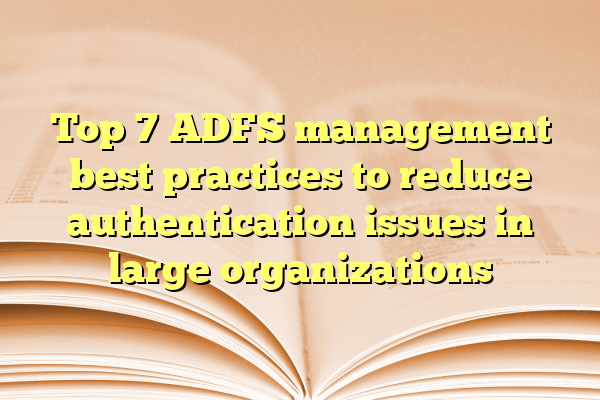
Top 7 ADFS management best practices to reduce authentication issues in large organizations
In today’s era of digital transformation, enterprise authentication systems are the backbone of secure access to applications and services. One such widely adopted identity provider is Active Directory Federation Services (ADFS), which enables Single Sign-On (SSO) capabilities across different applications and platforms. However, as large organizations scale, so does the complexity of managing ADFS—which can lead to authentication issues, user frustration, and business disruption.
If you’re responsible for managing ADFS in a growing company, here are the top seven best practices to reduce authentication issues and ensure a smooth experience for all users.
Contents
- 1 1. Implement Redundancy and High Availability
- 2 2. Keep ADFS and Dependencies Up to Date
- 3 3. Enable and Monitor ADFS Auditing
- 4 4. Optimize the Service Communications Certificate Lifecycle
- 5 5. Implement Smart Lockout and Extranet Lockout Features
- 6 6. Simplify Claims Rules Management
- 7 7. Regularly Test and Validate Authentication Scenarios
- 8 Final Thoughts
1. Implement Redundancy and High Availability
Downtime can be detrimental to user productivity when critical authentication services become temporarily unavailable. That’s why architecting for high availability (HA) is essential. Ensure your ADFS infrastructure includes:
- Multiple ADFS servers: Distribute the authentication load and provide failover support.
- Multiple Web Application Proxies (WAPs): Ensure external access remains available in case one proxy fails.
- Load balancers: Manage network traffic and automatically redistribute it in case of server failure.
By creating redundancy in each component of your ADFS deployment, you minimize the risk of downtime and significantly reduce authentication issues across users and business units.
2. Keep ADFS and Dependencies Up to Date
Authentication issues often stem from outdated software or misaligned dependencies. Regularly applying updates and patches to the ADFS server, supporting databases, and the underlying Windows Server is essential. These updates not only address security vulnerabilities but also fix bugs that could cause unexpected authentication errors.
Use automated tools like Windows Server Update Services (WSUS) or Microsoft Endpoint Configuration Manager to maintain version control across your server infrastructure. Also, validate updates in a staging environment before applying them in production to prevent unintentional disruptions.
3. Enable and Monitor ADFS Auditing
Understanding why an authentication issue occurred starts with good logging and visibility. ADFS includes built-in auditing capabilities that can help you track:
- Who tried to authenticate and when
- What claims were passed to relying applications
- Which errors were thrown and their corresponding failure reasons
Enable auditing using the Windows Event Viewer and monitor key event IDs like 1200 (authentication success) and 1203 (authentication failure). For enterprises, integrate logging into your SIEM (Security Information and Event Management) solution for real-time monitoring and alerting.

Proactively monitoring these logs can help you detect patterns, mitigate ongoing issues early, and reduce time-to-resolution for authentication failures.
4. Optimize the Service Communications Certificate Lifecycle
ADFS heavily relies on certificates—especially the Service Communications certificate used to secure external connections. However, certificate expiration is a common cause of ADFS outages.
To prevent this:
- Track certificate expiration dates and set up alerts
- Use durable certificates with longer lifecycles (2-3 years)
- Deploy certificate updates during planned maintenance windows
- Document manual steps so that stakeholders know what to do in case of expiry
If you’re using a public CA, consider automating renewals and installations using tools like Certify The Web or Let’s Encrypt. Be sure to also test certificate changes in a dev or QA environment before pushing to production.
5. Implement Smart Lockout and Extranet Lockout Features
With the rise of password spray and brute-force attacks, securing external authentication is more important than ever. ADFS offers Smart Lockout and Extranet Lockout functionalities to protect your users while ensuring legitimate access is still possible.
These features can help you:
- Throttle invalid login attempts
- Dynamically consider trusted versus unknown IP addresses
- Reduce false positives compared to traditional account lockout policies
Enable Smart Lockout through PowerShell and fine-tune thresholds for your organization’s usage pattern. Combining these features drastically improves your response to common external threats and reduces unnecessary authentication friction for legitimate users.
6. Simplify Claims Rules Management
Claims rules determine what information about a user is passed to federated applications. Over time, especially in large environments with many relying parties, these rules can become complex and poorly documented. This increases the risk of errors when deploying new apps or modifying configurations.
Best practices include:
- Using templates and reusable claims rules across relying parties
- Keeping documentation of each relying party trust and its associated claims
- Testing changes thoroughly using PowerShell or the ADFS debug trace tool before deployment

Additionally, consider segmenting roles so that only experienced ADFS administrators can edit claims rules. This reduces misconfigurations and makes troubleshooting easier in the long run.
7. Regularly Test and Validate Authentication Scenarios
Just because your ADFS environment is running doesn’t mean it’s working for every user and use case. Regular testing is critical—especially when deploying new applications, making changes to identity providers, or modifying certificates.
Validate common authentication scenarios such as:
- Internal vs. external authentication
- SSO with multi-factor authentication (MFA)
- Relying party trust with third-party SaaS apps
- Legacy application access using ADFS
Organizations with strong change control processes often use test scripts or automation tools to simulate authentication workflows and catch problems before they go live. This proactive approach helps reduce tickets related to login issues and minimizes disruptions.
Final Thoughts
Managing ADFS in a large organization comes with a unique set of challenges, but with the right practices in place, authentication issues can be significantly reduced. Always prioritize redundancy, monitoring, testing, and clear documentation. When done right, ADFS can be a cornerstone of efficient, secure, and reliable access across your enterprise ecosystem.
As your organization grows and increasingly adopts cloud-based services, consider evaluating whether a hybrid or cloud-native identity solution like Azure AD might better suit your long-term strategy. However, for those continuing with ADFS, following these seven best practices will ensure a robust and resilient identity infrastructure.
